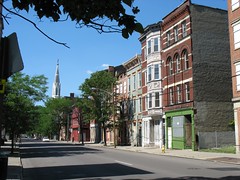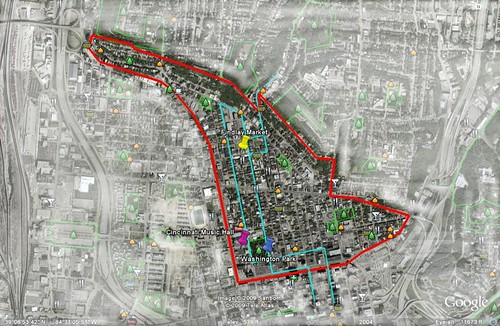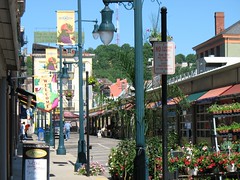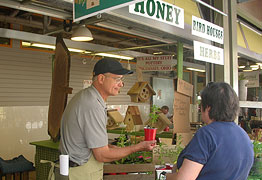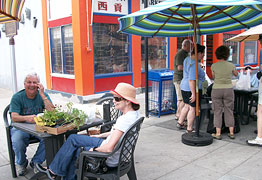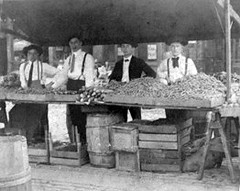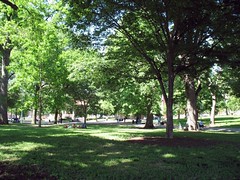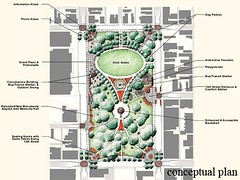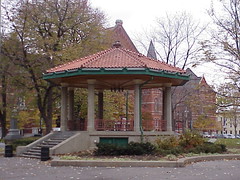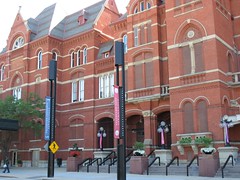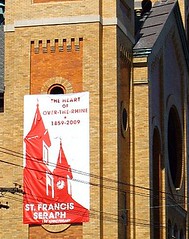Revitalizing Over-the-Rhine (Part 2: building on the neighborhood’s assets)

Posted June 8, 2009 at 1:18PM
Last week I wrote the first installment of my miniseries about Cincinnati's remarkable Over-the-Rhine neighborhood. As I wrote then, this distinct and historic quarter adjacent to Cincinnati's downtown is full of promise but bears considerable scars from decades of disinvestment, having declined in population from over 40,000 at its peak to under 10,000 today. Much of its splendid 19th-century architecture has suffered serious decay, and it has had all the problems of poverty and crime that plagued too many of our inner-city neighborhoods in the late 20th century. The good news, though, is that I believe OTR can become a nationally significant model of inclusive, green revitalization if everything falls into place.
One of the main reasons that I have much hope for Over-the-Rhine is that it has some tremendous neighborhood assets to build a recovery upon, starting not just with historic architecture but also with a resilient existing community of residents. My impression when visiting last month was that, poverty and problems notwithstanding, OTR feels like a real neighborhood and a real community. It will be critical that the neighborhood's restoration includes these residents at every step. As the city's comprehensive plan for the neighborhood notes:
"The committed residents and businesses that remain in the neighborhood today will be the backbone of the revitalization . . . [But] Making people feel respected, welcomed, valued and connected is a tall order."
No doubt. But the success of Old North St. Louis in approaching a very similar situation gives me a lot of hope that this can be done in the right way.
Let's continue with a close look at OTR's geography. As I noted last week, the neighborhood sits right between the central business district and the uptown University district, the region's two largest concentrations of employment. That's a terrific location, one that all the current urban trends suggest is highly favorable to recovery. Moreover, the neighborhood's 19th-century architectural scale, along with block sizes manageable for humans as well as for cars, make it ideal for walking.
In the satellite image above, three of OTR's most striking physical assets are marked with (virtual) push-pins. In the center-north, the yellow pin marks the historic and lively Findlay Market, Ohio's oldest. In the south, the blue pin identifies lovely Washington Park, with its old bandstand. And just to the west of the park is the fuchsia pin, marking the location of Cincinnati's enormous baroque Music Hall, where the symphony and opera perform. Look closely (or click on the image for an enlargement) and you can also see marks identifying various churches, schools, parks, markets, and eateries sprinkled around the neighborhood. (Google Earth is amazing; I had a lot of fun doing this.) We'll get to the light blue lines later in the post.
The Findlay Market is an old-fashioned public market that has been in continuous operation since 1858. According to its website, the Market is open year-round Tuesday through Sunday, hosting about two dozen local and regional merchants selling meat, fish, poultry, produce, flowers, cheese, and ethnic foods. In addition, on Saturdays and Sundays from April to November Findlay also hosts a farmers market, dozens of additional vendors, street performers, and special events. The website claims that it "routinely attracts perhaps the most socially, economically, racially, and ethnically diverse crowds found anywhere in Cincinnati," and I don't doubt it.
That the Market has remained economically healthy and is only becoming more robust is a great sign for the neighborhood. The website contains all the latest news and a wonderful short video that gives you a great sense of both the Market's history and its current place in the community (highly recommended).
My own walk through OTR began with Washington Park. I found the park, filled with trees and neighborhood-sized public spaces, to be only slightly worn for the wear. Kevin Lemaster writes on Building Cincinnati that the park will be getting its own renovation, expanding to the north, and getting an underground garage. I'm not sure why such a walkable, under-populated and transit-served neighborhood needs a new garage, but expansion onto what is now paved former school property is a great idea. I think the current park is pretty darn nice, so I hope the renovation is done sensitively. (I have no reason to believe it won't be.) I know lots of neighborhoods, city and suburban both, that would love to have a park like this.
There's a photo of the park's old bandstand just above, with the amazing Cincinnati Music Hall in the background. To the right is a separate photo of the Music Hall, which sits just across the street from the northwest corner of the park. Finished in 1878, the Hall's main auditorium seats 3500 people, and also includes a 20,000-square-foot ballroom, used for both performances and meetings, as well as assorted other gathering places.
One has to be struck by the contrast afforded by the presence of such a bastion of highbrow culture in a neighborhood beset with poverty, but I see the Hall as a huge plus, keeping OTR connected to its larger region and important potential sources of investment. Not to mention the architecture. Go to the website of the Society for the Preservation of Music Hall for some wonderful old pictures and a video of the installation of the Mighty Wurlitzer organ in the ballroom.
Those three are big-time assets for a revitalizing neighborhood, or any neighborhood. And I was also struck by the number of churches in Over-the-Rhine. While I was told that the neighborhood's population decline has meant that not all of them are still operating, many of them are. In many places institutions of faith can be important community building blocks, and I think their presence is another plus for OTR.
To top it all off, remember the light blue lines on the Google Earth image above? They mark the likely route of Cincinnati's almost-real new streetcar, which if all goes as planned will run continuously through the neighborhood. 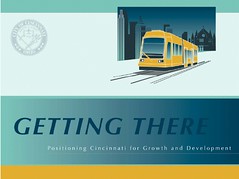 Earlier this year, the city council approved the streetcar, but there are still route details (beyond OTR) to be worked out, and my understanding is that the funding has not yet been fully assembled. This could be a huge boost to economic development in the neighborhood.
Earlier this year, the city council approved the streetcar, but there are still route details (beyond OTR) to be worked out, and my understanding is that the funding has not yet been fully assembled. This could be a huge boost to economic development in the neighborhood.
The experience in Portland, where a modern streetcar was introduced earlier this decade, has been that ridership has far exceeded expectations and that the service has been a major catalyst for nearby walkable development and reduced vehicle emissions. Go here to watch enthusiastic Cincinnati developer-turned-advocate John Schneider (with whom I shared breakfast one morning) make a persuasive case for the Cincinnati streetcar.
In the next, concluding installment, we'll look at the progress so far and the prospects for making it green.
